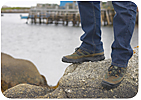
If, like me, you’ve experienced the harsh, biting cold of New England winters, or recall chilly summers spent working in the local grocer’s freezer, then you can appreciate how “state-of-the-market” footwear often falls short under these conditions.
Before making an investment in work footwear, educate yourself and your employees about the unique challenges that cold weather conditions present. Let’s look at four tips that can help you be better prepared to make a wise purchase.
1. Outsmart the elements
To begin, consider the environment in which you work. If you spend a substantial amount of time in cold, wet conditions, you’ll want quality-constructed, waterproof footwear. Options for occupational or regional style preferences include: 6" lace-ups, 8" lace-ups, pull-on boots, or even low-cuts (for moderately wet conditions and/or indoor use). Look for shoes (whether all-leather or a combination of leather and fabric) constructed with seam-sealed protection (stitch points along the shoe backed with a waterproof adhesive) or a waterproof membrane (barrier residing between the upper leather and lining), to prevent moisture penetration.2. Insulation — “more†isn’t always “betterâ€
Insulation choices vary widely — from 200 grams up to 1,600 grams found in some hunting footwear. But “more” doesn’t always equal “better” when it comes to insulation. Keep in mind that the more active your occupation, the more your feet sweat to cool themselves. Heavy insulation can capture some of this moisture and ultimately lead to discomfort. It’s important to dry out footwear each night. Stuffing boots or shoes with newspaper is one way to do this, coupled with air-drying.Also, remember that heavy insulation around the foot can lead to a somewhat bulky and inflexible design. While a long-time admirer of the astronaut Neil Armstrong, I still find it difficult to envision myself wearing those bulky moon boots to shovel snow or, worse still, put in an eight- to ten-hour workday.
3. Stay flexible
Cold weather can lead to stiff, inflexible soles. Many employees working in cold conditions long for the feeling of underfoot flexibility normally found in moderate or warm weather footwear. When you are evaluating footwear options, ask your retailer about boots and shoes featuring special outsole compounds that prolong flexibility in cold conditions.Flexible, resilient soles are not only important because of the cushioning provided, but are particularly important in promoting a more natural gait cycle or walking motion as one transitions from heel strike to toe-off. Stiff, inflexible soles force tendons and muscles to work much harder to propel one through his or her walking motion. The typical result is achy feet and tired legs — a difficult way to go about a long workday.
4. Protection from heel to toe
While much of the focus of foot safety is given to the toe area, effective insulation and protection shouldn’t end there. In addition to toe protection and insulation, industrial shoes and boots must also protect the entire foot, particularly the sole, from ground surface cold. Likewise, in steel-toe protective footwear, workers should not have to sacrifice impact protection in order to keep their toes warm.When it comes to cold environment footwear, ultimately efficient, effective protection is key. Special considerations such as insulation, flexibility and boot weight must be made when sizing up the best value, given the myriad of product options. Now, more than ever, choices in occupational footwear are breaking performance barriers — all for the benefit of workers in a host of environments.